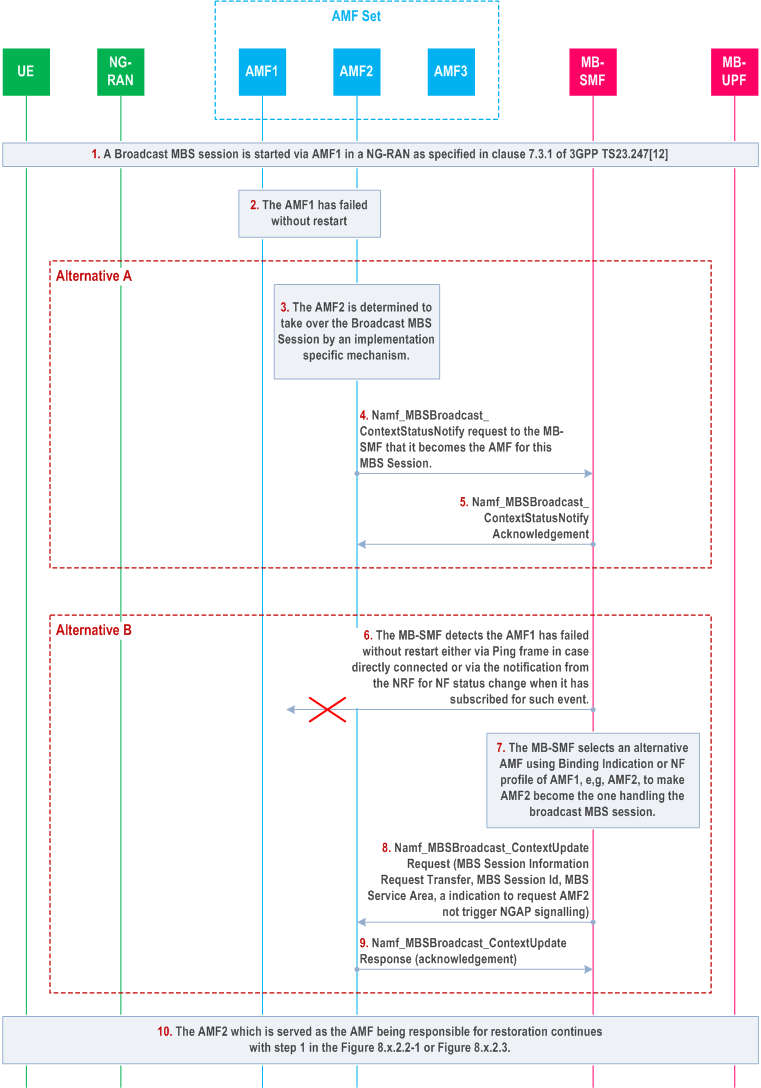Content for TS 23.527 Word version: 18.2.0
8.3.2.4 Selecting an alternative AMF for a Broadcast MBS Session at AMF failure p. 40
When the AMF selected by the MB-SMF to start a Broadcast MBS Session fails without restart, to support the restoration procedure to restore an Broadcast MBS Session in a restarted NG-RAN as specified in clauses 8.3.2.2 and 8.3.2.3, another AMF in the same AMF set needs to be selected to become the serving AMF for this broadcast MBS session and to be responsible for restoration. This may be done by one of the following solutions:
-
another AMF is selected in the same AMF set by an AMF implementation specific mechanism, and this AMF sends a Namf_
MBSBroadcast_ Request message to the MB-SMF to notify this optionally containing an updated binding indication; orContextStatusNotify -
when the MB-SMF detects that the AMF which was handling the Broadcast MBS session has failed without restart and no Namf_
MBSBroadcast_ Request is received from any AMF of the AMF set as described in the first bullet, the MB-SMF may reselect an alternative AMF by sending a Namf_ContextStatusNotify MBSBroadcast_ Request message with an indication that the alternative AMF needs not trigger any NGAP message to deliver the N2 container - MBS Session Setup or Modification Request Transfer, but just to store it for future potential NG-RAN restoration.ContextUpdate

Step 1.
A Broadcast MBS Session has been established in the network.
Step 2.
The AMF1 has failed without restart.
Step 3.
Alternative A: another AMF2 in the same AMF set is selected by an AMF implementation specific mechanism.
Step 4.
The AMF2 sends Namf_MBSBroadcast_ContextStatusNotify to the MB-SMF that the AMF2 becomes the AMF controlling the Broadcast MBS Session context.
Step 5.
The MB-SMF acknowledges the notification and will send subsequent signalling message for this Broadcast MBS Session via the AMF2.
Step 6.
Alternative B: the MB-SMF detects that the AMF1 has failed without restart either via HTTP/2 PING Frame for directly connected, or via notifications from the NRF for the NF Status Change when it has subscribed such event, and that no Namf_MBSBroadcast_ContextStatusNotify Request is received from any AMF of the AMF set as described in Alternative A.
Step 7.
The MB-SMF selects an alternative AMF pertaining to the same AMF set using the Binding Indication provided by the old AMF or using the NF profile of the old AMF.
Step 8.
The MB-SMF sends a Namf_MBSBroadcast_ContextUpdate Request including a MBS Session ID, the corresponding MBS Service Area, a MBS Session Setup or Modification Request Transfer, and sets the "noNgapSignallingInd" to "true" to request the AMF2 to be the AMF for the Broadcast MBS Session to handle subsequent MBS session signaling and be responsible for triggering restoration procedures for NG-RAN failure with or without restart. The AMF may consider to not trigger any NGAP signalling towards NG-RANs covering the MBS service area.
Step 9.
The AMF responds the Namf_MBSBroadcast_ContextUpdate Request message.
Step 10.
The AMF2 continues with the procedures as specified in clauses 8.3.2.2 and 8.3.2.3.